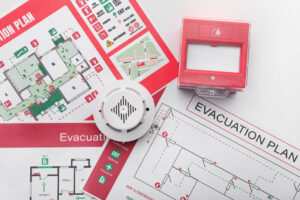The 2021 Texas winter storm hit hard. The extreme weather brought snow, sleet, freezing rain, and record-breaking cold temperatures to the state for several days. This storm was one of the most impactful weather events in recent history. Texas faced weeks of road closures, power outages, broken pipes, and other damages to infrastructure.
As the seasons shift, now is the time to plan and prepare for the possibility of another winter storm. Here are ways to protect your property and family if the weather stirs.
Preparing Your Home for Winter Weather
1. Know Your Insurance Coverage
Ahead of the threat of winter weather, refamiliarize yourself with your home or renters insurance policy. If temperatures drop and pipes freeze, policies might not pay for those damages. Some policies also pay to replace lost food items if the power goes out and food spoils in the fridge. Understand your coverage and the steps you need to take to ensure you can file a claim if something happens. Also, make a note of who to contact from your insurance company.
2. Prepare For Forzen Pipes
Frozen and broken pipes can lead to thousands of dollars in water damage. Take precautions leading up to dropping temperatures and during the storm to prevent your pipes from freezing.
Preparing Pipes Before Temperatures Drop:
- Wrap outdoor and indoor pipes in unheated areas
- Drain indoor house fire sprinklers
- Remove water hoses
- Drain and turn off your lawn sprinkler system
- Turn off the water to your washing machine if it’s in an unheated garage
- If you leave your house before a freeze, turn off the water at the shutoff valve and leave your heat on
Protecting Pipes During a Freeze:
- Leave faucets to drip from the cold and hot taps
- Open cabinets under sinks to let your house’s heat warm the pipes
- If your pipes freeze, turn off the water at the shutoff valve right away– This prevents broken pipes from leaking into your house after they thaw.
3. Alternative Heat Source Safety
Not every home has a wood stove or fireplace. What do you do if you lose power and temperatures remain freezing? There are several different types of alternative heat sources for emergencies. But use caution! Alternative heat sources can be a significant fire hazard.
Survey the space you plan to heat when picking an alternative heat source. First, you want to take steps to slow down the loss of heat from your home. Pick a room or two to focus on heating. Close all the windows, blinds, and doors to all other rooms. Small spaces require less power to heat than larger spaces.
Second, experiment and practice first. Do not purchase an alternative heating device, then store it away for when you need it. Learn everything about it and make sure you have all of the accessories you may need. Understand how to use it before you need it. Most importantly, safely store any fuel!
When getting an alternative heat source, make sure it is intended to be used inside or for your specific space. Next, understand the risks of using alternative heating sources. Non-electric heaters are not designed to keep your entire home at a toasty 74 degrees for days on end. Be realistic in your expectations. If you use any form of alternative heating, make sure you have a carbon monoxide detector.
Never use a generator indoors. Even outside, make sure to keep it in a well-ventilated space at least 20 feet from doors, windows, or vents. Never use a generator in a garage, even if the door is open. Don’t put fuel in a hot generator. Turn it off and let it cool first. Be sparing in what you power.
When using space heaters, keep on hard, level surfaces. Always keep space heaters at least 3 feet away from any flammable materials. Keep a fire extinguisher nearby, and know how to use it.
Avoid the DIY home heating options. Coleman pack heater, Alcohol Fuel heater, terracotta pot candle heaters, or candles are not safe. Prepare now and invest in an alternative heating source that is safe for your space.
Prepare Your Family for Texas Freeze
1. Make a Family Disaster Plan
When making a plan, consider whether you will evacuate or shelter in place. If the storm brings unexpected severe weather, families need to know how to communicate. Determine what you will do if you shelter in place and lose power. How will you care for your animals? What if someone in your household has special needs? What if you lose power?
Prepare your home ahead of time, stock up on supplies, and create actionable steps for when the weather hits. You need to know how to shut off the water, reduce fire hazards, and keep everyone safe. Disasters are stressful. Creating a plan ahead of time eases communication between family members when the weather comes.
If you live close to others, get to know your neighbors. Speak with them about their safety plans. Rely on each other for help if unexpected severe weather hits.
2. Be Ready to Leave
If the weather worsens, your home is damaged, or your well-being is in jeopardy, be ready to seek shelter. Before the weather hits, plan for where you will go and how you will get there. Have essential documents, such as insurance plans, Social Security card, driver’s license, passport, and birth certificates ready to go. Additionally, put together a go-bag with extra clothing, medications, and other essentials for traveling and staying at the place you choose to go to.
3. Set Up Alternative Communications
Purchase means to keep communication open in the case of an emergency. Stock up on fully-charged portable chargers for mobile devices and battery-powered radios. If the power goes out, have a way to get weather and emergency alerts. If mobile devices die, write down or memorize important phone numbers and radio stations.
4. Take Inventory and Stock Up
Prepare now to be stuck at home in the event that a winter storm shuts down roadways or knocks out the power. Take inventory of the food and utility items you have now, and start stocking up on things you need to replenish.
Items to keep on hand include:
- Bottled water
- At least a 3-day supply for each household member
- At least 1 gallon of water per pet
- Nonperishable food
- Such as dried fruit, nuts, cereal, and granola bars
- Batteries
- Cash
- First-aid Kit
- Flashlights
- Warm clothes and blankets
- Shovel & Bucket
- Prescription Medications
After the Winter Event
Once temperatures warm up and the winter weather passes, don’t rush to turn all the power and water back on. First, check with your power and utility providers for updates on storm damage. If your neighborhood experienced damage, you might have to take extra precautions when turning the water back on. If the water was shut off for multiple days, it might not be safe to use yet. Follow local authority guidelines.
When it is time to turn the water back on, ensure there is no damage. If no water comes out of the faucets, that could indicate some freezing, but don’t panic. This does not mean damaged pipes. But check with a plumber to be sure. Listen for water running when the water is off. If you hear running water, that could mean a pipe has burst.
Additional Resources for Winter Preparedness
There are several resources available to help you continue preparations in the event of a winter freeze. Here are more tips and safety plans from local resources:
- Texas Monthly: 14 Ways to Prepare for Winter Freeze
- Texas A&M: Winter Storm Preparedness
- KUT 90.5 NPR: Worried About Severe Weather? Here’s How to Prepare
- Red Cross: Winter Storm Safety
- KXAN: Winter Weather Checklist
Winter Weather at Travisso
Travisso is preparing for if another winter disaster hits Central Texas. If the weather worsens, make sure to sign up for alerts from Travisso and follow our social media channels for the latest news in the community. Additionally, we recommend you familiarize yourself with the HOA portal to keep up-to-date on how to contact in case of an emergency.


